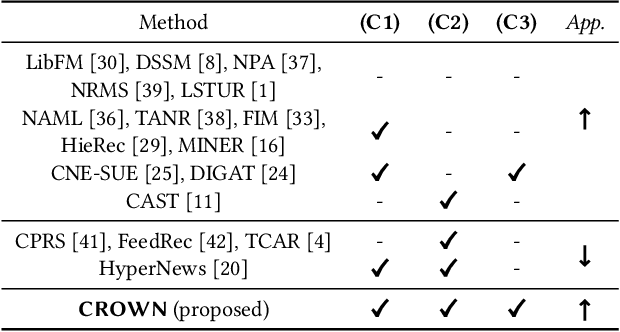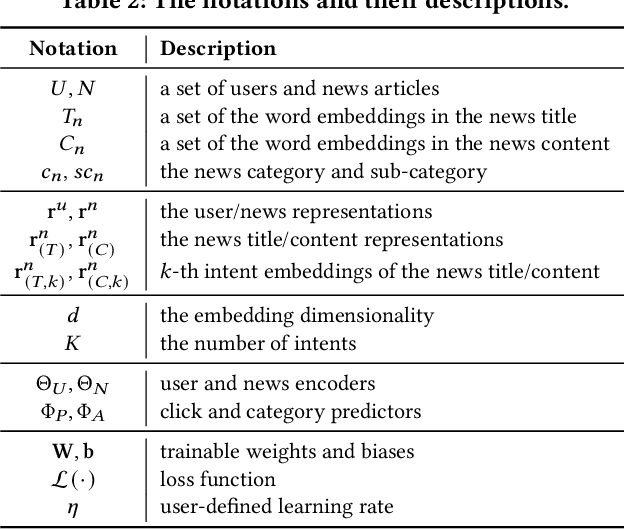Sang-Wook Kim
Learning Short-Term and Long-Term Patterns of High-Order Dynamics in Real-World Networks
Aug 24, 2025Abstract:Real-world networks have high-order relationships among objects and they evolve over time. To capture such dynamics, many works have been studied in a range of fields. Via an in-depth preliminary analysis, we observe two important characteristics of high-order dynamics in real-world networks: high-order relations tend to (O1) have a structural and temporal influence on other relations in a short term and (O2) periodically re-appear in a long term. In this paper, we propose LINCOLN, a method for Learning hIgh-order dyNamiCs Of reaL-world Networks, that employs (1) bi-interactional hyperedge encoding for short-term patterns, (2) periodic time injection and (3) intermediate node representation for long-term patterns. Via extensive experiments, we show that LINCOLN outperforms nine state-of-the-art methods in the dynamic hyperedge prediction task.
COHESION: Composite Graph Convolutional Network with Dual-Stage Fusion for Multimodal Recommendation
Apr 06, 2025



Abstract:Recent works in multimodal recommendations, which leverage diverse modal information to address data sparsity and enhance recommendation accuracy, have garnered considerable interest. Two key processes in multimodal recommendations are modality fusion and representation learning. Previous approaches in modality fusion often employ simplistic attentive or pre-defined strategies at early or late stages, failing to effectively handle irrelevant information among modalities. In representation learning, prior research has constructed heterogeneous and homogeneous graph structures encapsulating user-item, user-user, and item-item relationships to better capture user interests and item profiles. Modality fusion and representation learning were considered as two independent processes in previous work. In this paper, we reveal that these two processes are complementary and can support each other. Specifically, powerful representation learning enhances modality fusion, while effective fusion improves representation quality. Stemming from these two processes, we introduce a COmposite grapH convolutional nEtwork with dual-stage fuSION for the multimodal recommendation, named COHESION. Specifically, it introduces a dual-stage fusion strategy to reduce the impact of irrelevant information, refining all modalities using ID embedding in the early stage and fusing their representations at the late stage. It also proposes a composite graph convolutional network that utilizes user-item, user-user, and item-item graphs to extract heterogeneous and homogeneous latent relationships within users and items. Besides, it introduces a novel adaptive optimization to ensure balanced and reasonable representations across modalities. Extensive experiments on three widely used datasets demonstrate the significant superiority of COHESION over various competitive baselines.
HyGEN: Regularizing Negative Hyperedge Generation for Accurate Hyperedge Prediction
Feb 09, 2025



Abstract:Hyperedge prediction is a fundamental task to predict future high-order relations based on the observed network structure. Existing hyperedge prediction methods, however, suffer from the data sparsity problem. To alleviate this problem, negative sampling methods can be used, which leverage non-existing hyperedges as contrastive information for model training. However, the following important challenges have been rarely studied: (C1) lack of guidance for generating negatives and (C2) possibility of producing false negatives. To address them, we propose a novel hyperedge prediction method, HyGEN, that employs (1) a negative hyperedge generator that employs positive hyperedges as a guidance to generate more realistic ones and (2) a regularization term that prevents the generated hyperedges from being false negatives. Extensive experiments on six real-world hypergraphs reveal that HyGEN consistently outperforms four state-of-the-art hyperedge prediction methods.
CAPER: Enhancing Career Trajectory Prediction using Temporal Knowledge Graph and Ternary Relationship
Aug 28, 2024



Abstract:The problem of career trajectory prediction (CTP) aims to predict one's future employer or job position. While several CTP methods have been developed for this problem, we posit that none of these methods (1) jointly considers the mutual ternary dependency between three key units (i.e., user, position, and company) of a career and (2) captures the characteristic shifts of key units in career over time, leading to an inaccurate understanding of the job movement patterns in the labor market. To address the above challenges, we propose a novel solution, named as CAPER, that solves the challenges via sophisticated temporal knowledge graph (TKG) modeling. It enables the utilization of a graph-structured knowledge base with rich expressiveness, effectively preserving the changes in job movement patterns. Furthermore, we devise an extrapolated career reasoning task on TKG for a realistic evaluation. The experiments on a real-world career trajectory dataset demonstrate that CAPER consistently and significantly outperforms four baselines, two recent TKG reasoning methods, and five state-of-the-art CTP methods in predicting one's future companies and positions-i.e., on average, yielding 6.80% and 34.58% more accurate predictions, respectively.
Disentangling, Amplifying, and Debiasing: Learning Disentangled Representations for Fair Graph Neural Networks
Aug 23, 2024Abstract:Graph Neural Networks (GNNs) have become essential tools for graph representation learning in various domains, such as social media and healthcare. However, they often suffer from fairness issues due to inherent biases in node attributes and graph structure, leading to unfair predictions. To address these challenges, we propose a novel GNN framework, DAB-GNN, that Disentangles, Amplifies, and deBiases attribute, structure, and potential biases in the GNN mechanism. DAB-GNN employs a disentanglement and amplification module that isolates and amplifies each type of bias through specialized disentanglers, followed by a debiasing module that minimizes the distance between subgroup distributions to ensure fairness. Extensive experiments on five datasets demonstrate that DAB-GNN significantly outperforms ten state-of-the-art competitors in terms of achieving an optimal balance between accuracy and fairness.
HearHere: Mitigating Echo Chambers in News Consumption through an AI-based Web System
Feb 29, 2024Abstract:Considerable efforts are currently underway to mitigate the negative impacts of echo chambers, such as increased susceptibility to fake news and resistance towards accepting scientific evidence. Prior research has presented the development of computer systems that support the consumption of news information from diverse political perspectives to mitigate the echo chamber effect. However, existing studies still lack the ability to effectively support the key processes of news information consumption and quantitatively identify a political stance towards the information. In this paper, we present HearHere, an AI-based web system designed to help users accommodate information and opinions from diverse perspectives. HearHere facilitates the key processes of news information consumption through two visualizations. Visualization 1 provides political news with quantitative political stance information, derived from our graph-based political classification model, and users can experience diverse perspectives (Hear). Visualization 2 allows users to express their opinions on specific political issues in a comment form and observe the position of their own opinions relative to pro-liberal and pro-conservative comments presented on a map interface (Here). Through a user study with 94 participants, we demonstrate the feasibility of HearHere in supporting the consumption of information from various perspectives. Our findings highlight the importance of providing political stance information and quantifying users' political status as a means to mitigate political polarization. In addition, we propose design implications for system development, including the consideration of demographics such as political interest and providing users with initiatives.
Towards Fair Graph Anomaly Detection: Problem, New Datasets, and Evaluation
Feb 25, 2024



Abstract:The Fair Graph Anomaly Detection (FairGAD) problem aims to accurately detect anomalous nodes in an input graph while ensuring fairness and avoiding biased predictions against individuals from sensitive subgroups such as gender or political leanings. Fairness in graphs is particularly crucial in anomaly detection areas such as misinformation detection in search/ranking systems, where decision outcomes can significantly affect individuals. However, the current literature does not comprehensively discuss this problem, nor does it provide realistic datasets that encompass actual graph structures, anomaly labels, and sensitive attributes for research in FairGAD. To bridge this gap, we introduce a formal definition of the FairGAD problem and present two novel graph datasets constructed from the globally prominent social media platforms Reddit and Twitter. These datasets comprise 1.2 million and 400,000 edges associated with 9,000 and 47,000 nodes, respectively, and leverage political leanings as sensitive attributes and misinformation spreaders as anomaly labels. We demonstrate that our FairGAD datasets significantly differ from the synthetic datasets used currently by the research community. These new datasets offer significant values for FairGAD by providing realistic data that captures the intricacies of social networks. Using our datasets, we investigate the performance-fairness trade-off in eleven existing GAD and non-graph AD methods on five state-of-the-art fairness methods, which sheds light on their effectiveness and limitations in addressing the FairGAD problem.
VITA: 'Carefully Chosen and Weighted Less' Is Better in Medication Recommendation
Dec 19, 2023Abstract:We address the medication recommendation problem, which aims to recommend effective medications for a patient's current visit by utilizing information (e.g., diagnoses and procedures) given at the patient's current and past visits. While there exist a number of recommender systems designed for this problem, we point out that they are challenged in accurately capturing the relation (spec., the degree of relevance) between the current and each of the past visits for the patient when obtaining her current health status, which is the basis for recommending medications. To address this limitation, we propose a novel medication recommendation framework, named VITA, based on the following two novel ideas: (1) relevant-Visit selectIon; (2) Target-aware Attention. Through extensive experiments using real-world datasets, we demonstrate the superiority of VITA (spec., up to 5.56% higher accuracy, in terms of Jaccard, than the best competitor) and the effectiveness of its two core ideas. The code is available at https://github.com/jhheo0123/VITA.
MONET: Modality-Embracing Graph Convolutional Network and Target-Aware Attention for Multimedia Recommendation
Dec 15, 2023



Abstract:In this paper, we focus on multimedia recommender systems using graph convolutional networks (GCNs) where the multimodal features as well as user-item interactions are employed together. Our study aims to exploit multimodal features more effectively in order to accurately capture users' preferences for items. To this end, we point out following two limitations of existing GCN-based multimedia recommender systems: (L1) although multimodal features of interacted items by a user can reveal her preferences on items, existing methods utilize GCN designed to focus only on capturing collaborative signals, resulting in insufficient reflection of the multimodal features in the final user/item embeddings; (L2) although a user decides whether to prefer the target item by considering its multimodal features, existing methods represent her as only a single embedding regardless of the target item's multimodal features and then utilize her embedding to predict her preference for the target item. To address the above issues, we propose a novel multimedia recommender system, named MONET, composed of following two core ideas: modality-embracing GCN (MeGCN) and target-aware attention. Through extensive experiments using four real-world datasets, we demonstrate i) the significant superiority of MONET over seven state-of-the-art competitors (up to 30.32% higher accuracy in terms of recall@20, compared to the best competitor) and ii) the effectiveness of the two core ideas in MONET. All MONET codes are available at https://github.com/Kimyungi/MONET.
CIDER: Category-Guided Intent Disentanglement for Accurate Personalized News Recommendation
Oct 13, 2023



Abstract:Personalized news recommendation aims to assist users in finding news articles that align with their interests, which plays a pivotal role in mitigating users' information overload problem. Although many recent works have been studied for better user and news representations, the following challenges have been rarely studied: (C1) How to precisely comprehend a range of intents coupled within a news article? and (C2) How to differentiate news articles with varying post-read preferences in users' click history? To tackle both challenges together, in this paper, we propose a novel personalized news recommendation framework (CIDER) that employs (1) category-guided intent disentanglement for (C1) and (2) consistency-based news representation for (C2). Furthermore, we incorporate a category prediction into the training process of CIDER as an auxiliary task, which provides supplementary supervisory signals to enhance intent disentanglement. Extensive experiments on two real-world datasets reveal that (1) CIDER provides consistent performance improvements over seven state-of-the-art news recommendation methods and (2) the proposed strategies significantly improve the model accuracy of CIDER.
 Add to Chrome
Add to Chrome Add to Firefox
Add to Firefox Add to Edge
Add to Edge